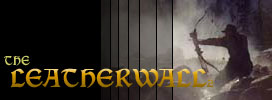| From: David McLendon
|
|
|
|
|
|
|
| Date: 25-Feb-18 |
|
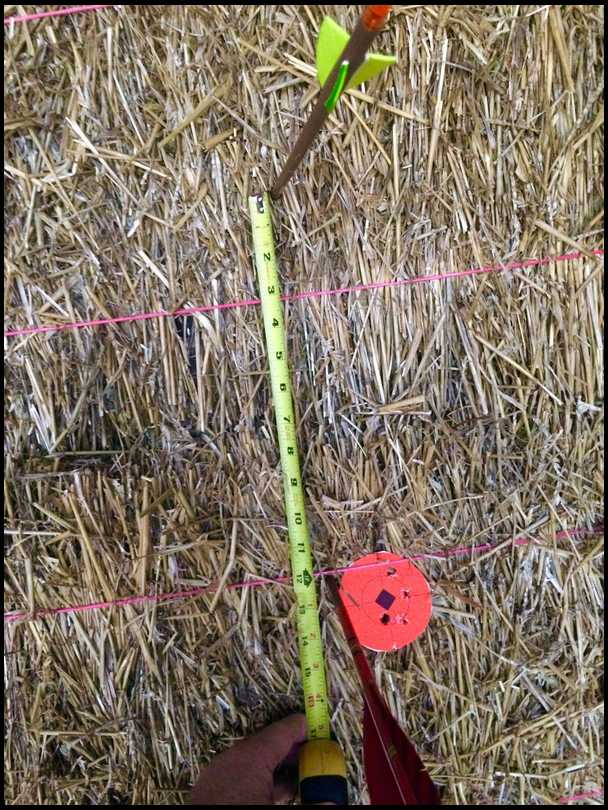
Two arrows identical other than fletching, one with 5" Left Helical Shield, the other with 2" Left helical Rayzor. Both arrows shot 3 under point on the target at 30 yards, the 5 " fletched arrow is on at 30 yards, the 2" fletched arrow is exactly 12" higher and gets there quicker penetrating deeper by 2.5". There is no way to claim that the bale density is the same in both landing spots, but the Rayzor fletched arrow did repeatedly penetrate 2- 2.5" deeper. This is a good illustration of the effect of different fletching types on the trajectory of like arrows from the same bow. Both arrows stabilize the same broadhead effectively and leave the bow at the same speed and energy level, but one manages that speed and energy more efficiently. YMMV
|
|
|
|
| From: fdp
|
|
|
|
|
|
|
| Date: 25-Feb-18 |
|
Very interesting to say the least. There will be those that make claims that your testing was flawed (just how it is).
But the fact that there is what, 50% less surface area drag with the 2.5" feather has to lead to an arrow traveling faster.
|
|
| From: George D. Stout
|
|
|

|
|
|
|
| Date: 25-Feb-18 |
|
It's called drag/friction...air resistance, and something that should be expected. Your mileage may also vary due to your form dynamics. Do it ten times and throw out the highest and lowest factor and you will have an average. For you.
|
|
| From: Mountain Man
|
|
|
|
|
|
|
| Date: 25-Feb-18 |
|
Id be interested in seeing the difference in a cross wind or over a chronograph Less surface area will determine less resistance aerodynamicly but i wonder if the gained speed from that would be enough to over come a variable as in wind and weather once loosed compared to the bigger fletchings
|
|
| From: David McLendon
|
|
|
|
|
|
|
| Date: 25-Feb-18 |
|
It doesn't travel faster as both leave the bow at the same speed, but it gives up less of its energy to drag thus carrying it's speed farther downrange, covering the same distance in less time resulting in a flatter trajectory.
|
|
| From: StikBow
|
|
|
|
|
|
|
| Date: 25-Feb-18 |
|
A darn near perfectly tuned arrow to the shooter and the bow are required to get the results. Everyone’s mileage may vary
|
|
| From: David McLendon
|
|
|
|
|
|
|
| Date: 25-Feb-18 |
|
It's a 2" feather, probably close to 60% less than 3X5".
|
|
| From: David McLendon
|
|
|
|
|
|
|
| Date: 25-Feb-18 |
|
Skip you are correct, perfect arrow tuning is required, also form and release are critical.
Scott, at 15 feet in front of the bow both arrows would chronograph essentially the same as they are the same shaft just fletched differently. They both leave the bow at the same speed, the smaller fletching does not make speed, it conserves the same initial speed through less drag. If you were to chronograph them both right in front of the target bale then there you would see a velocity differential favoring the short fletched arrow. However with the difference in trajectory at 30 yards, it would be risky shooting at best trying to get the both through the screens.
|
|
| From: Rick Barbee
|
|
|
|
|
|
|
| Date: 25-Feb-18 |
|
[[[ It doesn't travel faster as both leave the bow at the same speed, but it gives up less of its energy to drag thus carrying it's speed farther downrange, covering the same distance in less time resulting in a flatter trajectory. ]]]
Yep
|
|
| From: David McLendon
|
|
|
|
|
|
|
| Date: 25-Feb-18 |
|
The spin rate is the same for both arrows, both were fletched in the same jig, one is doing it with quite a bit less feather. I'm not saying but wondering if the 5" which is like a sail compared to the Rayzor might not catch more of a crosswind than less fletch spinning at the same rate and be more affected by it. That is something that would be hard to create and duplicate in strict testing and would be more likely with side by side shooting over distance on a windy day where a constant is unlikely. either way results are likely to be skewed and somewhat subjective.
|
|
| From: lefty4
|
|
|
|
|
|
|
| Date: 25-Feb-18 |
|
Bowmania must be sleeping in this morning. ;^)
|
|
| From: lefty4
|
|
|
|
|
|
|
| Date: 25-Feb-18 |
|
I would argue that the arrow with the smaller fletching is also leaving the bow a LITTLE faster.
1. That arrow weighs a little less. 2. There would be less air resistance on this arrow while it is still on the string moving forward. The smaller feathers would experiebce less resistance/drag. And more helix would create more resistance/drag.
|
|
| From: David McLendon
|
|
|
|
|
|
|
| Date: 25-Feb-18 |
|
Two inch is the extreme unless you try just two of them, I shoot these with my broadheads just fine. This is not for everybody, and I am not advocating it for anybody, just pointing it out. This or somewhere in between may work well for somebody else, after much consideration I am in the process of overhauling my method and giving up instinctive and doing a lot of testing with different arrow weights and fletching searching for what is going to fit my needs. I have used the Rayzor shooting instinctive and they work great once you learn the extended downrange aspects, but the jury is out as to whether it will fit my needs going forward, likely the solution may be somewhere in between but I have the luxury starting fresh to search out the ideal.
|
|
| From: Rick Barbee
|
|
|
|
|
|
|
| Date: 25-Feb-18 |
|
Whats the weight of the Razors compared to the 5" shields.
I bet they are lighter in weight, thus increasing your FOC, and the FOC is what helped the arrow maintain a better trajectory.
:-)
Rick
|
|
| From: David McLendon
|
|
|
|
|
|
|
| Date: 25-Feb-18 |
|
Doug, the difference in the weight of the fletching is 3 grains, so pretty much insignificant given the weight spread frequently encountered with other arrow components.
Helical spin does not create drag so much as the surface area of the fletching material.
|
|
| From: lefty4
|
|
|
|
|
|
|
| Date: 25-Feb-18 |
|
Good point Rick about the FOC. David now has to go back outside and retest after wrapping some drag-free tape on the back end of the Razored shaft to compensate for the weight.
|
|
| From: Mpdh
|
|
|
|
|
|
|
| Date: 25-Feb-18 |
|
Are the razor feathers higher than the shield cuts? If they are, some of the difference in POI May be due to more contact with the riser.
MP
|
|
| From: David McLendon
|
|
|
|
|
|
|
| Date: 25-Feb-18 |
|
i should have said 1 grain per feather for a total weight difference of 3 grains on average.
|
|
| From: Pdiddly
|
|
|
|
|
|
|
| Date: 25-Feb-18 |
|
Now that is a very interesting test.
I have never put much, if any, stock in chrono results or video's of 15 yard shots to judge a bow's performance.
An arrow can go through the beams three feet from the bow at a fine rate of speed but already be porpoising or tail-wagging all the way to the target, losing speed and not hitting in line. If that same arrow is very light it can appear to make the bow look like a rocket launcher but the arrow's performance can be terrible. I am far more interested in results like David's that record what happened 30 yards downrange.
Both those arrows undoubtedly left the bow at the same speed.
The extra fletch is clearly what made the difference and that is a logical assumption in terms of drag, a very real force on an object in motion.
Crookedstix tests are also of value as they attempt to measure one bow's performance against another with multiple trials using the same parameters.
|
|
| From: David McLendon
|
|
|
|
|
|
|
| Date: 25-Feb-18 |
|
"Good point Rick about the FOC. David now has to go back outside and retest after wrapping some drag-free tape on the back end of the Razored shaft to compensate for the weight."
Hah Hah! Nahhh, David's not going to do that ;^) Gotta leave some meat on the bone for anybody interested in playing with it.
These are leftover from my instinctive shooting career for when I wanted a flatter shooting arrow without giving up arrow weight. Caribou hunting was the focus, anybody who has doen that knows that they have a tendency to pass farther waway than you like. They may not fit into the gap profile that I need for a fixed crawl.
|
|
| From: David McLendon
|
|
|
|
|
|
|
| Date: 25-Feb-18 |
|
Pdiddy gets it...
"Are the razor feathers higher than the shield cuts? If they are, some of the difference in POI May be due to more contact with the riser. MP "
5" shield cut is 5/8" high
2" Rayzor is 1/2" high
"
|
|
| From: DerekMac
|
|
|
|
|
|
|
| Date: 25-Feb-18 |
|
Very interesting. Thanks for sharing.
|
|
| From: Rick Barbee
|
|
|
|
|
|
|
| Date: 25-Feb-18 |
|
Anyone ever try using turbulators?
Rick
|
|
| From: ny yankee
|
|
|
|
|
|
|
| Date: 25-Feb-18 |
|
I really think we need to do whatever it takes to tune to get down to NO fletching at all.
|
|
| From: David McLendon
|
|
|
|
|
|
|
| Date: 25-Feb-18 |
|
Actually Jamse with the 2" that is very true.
I like many when bareshafting for "big feather" tend to stop with the shaft showing just slightly weak to allow for the fletching stiffening it up and bringing it in line when finished. ou don't get as much of a stiffening effect with the Rayzor, now atthe same time if you tune to absolute dead on before fletching and then add the Rayzor fletch you will end up whith an arrow showing stiff. It's a much finer line tuning wise for the Rayzor fletch and I found that when getting close but still showing on the weak side that going ahead and fletching while doing final tuning and reducing the amount that I trim by at least half prevents going too far to the stiff side. My last cut for adjustment is usually 1/16"-1/8" and that small amount makes a significant difference.
|
|
| From: David McLendon
|
|
|
|
|
|
|
| Date: 25-Feb-18 |
|
I want to be clear that this is not a tutorial on short fletching nor am I necessarily advocating it. I am just doing a lot of testing as I go through my change and this was an incidence of two arrows being identical except for the fletching and it does show the difference between the two. If it give you something to think about that may benefit in some way down the road then it has served a purpose.
|
|
| From: Kodiaktd
|
|
|
|
|
|
|
| Date: 25-Feb-18 |
|
X2 with ny yankee
|
|
| From: bigdog21
|
|
|
|
|
|
|
| Date: 25-Feb-18 |
|
this has been a none fact for years most target shooter always shoot small fletching less drag and less wind drift. but as a hunter with a big broadhead you stand a greater chance of the head taking over steering the arrow because of less drag especially on a windy day. to me it is not worth the trade off for what you are gaining. for target and 3-d there is no argument smaller is better. the compound shooters started using smaller fletching for speed and vane clear ens but ended up having troubles tuning big fixed heads. this is why the mechanical open on impact head became so popular with them. now if you want the best of both put a flipper rest or a spring rest and shoot 4" vanes. less drag but big enough to steer the arrow?
|
|
| From: David McLendon
|
|
|
|
|
|
|
| Date: 25-Feb-18 |
|
I have found that with a 160 grain broadhead that it is adequate. It is however dependent upon the quality of tune and the form and release of the shooter. Likely the best solution lies somewhere in between. I am beginning to wonder about the default judgement that more equals better stability in the wind as more feather is more for the wind to catch and blow off course. If I can think of a way to accurately test that with predictable repeatable results I will but it'll likely remain pretty much every individual's opinion which can be proven is worth pretty much the price paid for it.
|
|
| From: David McLendon
|
|
|
|
|
|
|
| Date: 25-Feb-18 |
|
One thing that comes to mind is which is easy to carry broadside in a stiff wind, a 2"X6"X8" board or a '4X8' sheet of plywood?
|
|
| From: Rick Barbee
|
|
|
|
|
|
|
| Date: 25-Feb-18 |
|
I refuse to get into an argument about fletching size.
I'm simply going to say - "Tuning trumps everything", and the better you are tuned, the less fletching you will need.
4" is more than adequate for even the largest of broadheads (even in the wind) as long as the fletching isn't having to overcome errant tuning from the get go. Even 2" will do the job quite well as long as the arrows are tuned properly.
ny yankee said it best - "tune to get down to NO fletching at all."
Do that, and "any" fletching is just icing on the cake.
Rick
|
|
| From: Archergreg
|
|
|
|
|
|
|
| Date: 25-Feb-18 |
|
A short fletch can also make for a good training tool. Larger fletches mask some form and tuning errors.
|
|
| From: Orion
|

|
|

|
|
|
|
| Date: 25-Feb-18 |
|
Interesting, David. I would expect the direction of the results of your test, but not the magnitude. Twelve inches at 30 yards is a lot.
I started to convert from 3 five-inch to 4 four-inch fletches a while ago. The 4 four-inch still represent a little more overall feather area, though. Might do some testing with three four-inch feathers. Don't think I'll ever go shorter than that. Just don't like the way real short feathers look. Go figure :>)
I don't think the default judgment is that more fletching equals better stability in the wind. I always thought the default was just the opposite, i.e., less fletching is better in the wind. Big fletching may work to stabilize a large broadhead more quickly, but it's a hindrance in the wind.
A caribou hunt is still on my bucket list. Always seems to be windy in caribou country. If I ever get to make such a hunt, I know I'll be trimming the height of my fletching by about an eight inch or so.
|
|
| From: JusPassin
|
|
|

|
|
|
|
| Date: 25-Feb-18 |
|
I would like to see one test that shows high FOC improving trajectory, since that would be the exact opposite of what the testing of long aerodynamic bodies was shown to do when the Olympic Commission studied the FOC allowed for javelins.
They actually increased FOC so as to get the javelins to dive to the ground sooner to eliminate excessively long throws.
|
|
| From: David McLendon
|
|
|
|
|
|
|
| Date: 25-Feb-18 |
|
A big benefit particularly to those using an aiming system, but also to those that are not, is illustrated by these two arrows. That is the ability to move your point on distance and manipulate the profile of your trajectory so as to move the section of closest gaps within the optimum/desired range by varying the size of your fletching.
|
|
| From: Orion
|

|
|

|
|
|
|
| Date: 25-Feb-18 |
|
Hmmm. I don't do much target shooting anymore, but isn't arrow length regulated in most big shoots? I.e., aren't all of a specific archer's arrows supposed to be the same length to preclude an advantage for difference distances using gapping/point on.
Maybe the organizers will have to start looking at fletching configuration as well. Maybe they already do. I don't know.
|
|
| From: JusPassin
|
|
|

|
|
|
|
| Date: 25-Feb-18 |
|
I think your absolutely correct Dave. I mentioned this in a recent post that most folks use way more fletch than needed, either to hide poor tuning, or just purely for esthetics.
|
|
| From: David McLendon
|
|
|
|
|
|
|
| Date: 25-Feb-18 |
|
I'm about to expand the test with some 3.5" shields which is halfway between the 2 & 5. Results to follow shortly
|
|
| From: flyguysc
|
|
|
|
|
|
|
| Date: 25-Feb-18 |
|
As I said stabilise your arrows faster with the TURBULATOR a D.I.Y cheap and effective.
The Turbulator in this context is simply a raised ringed surface of fletching tape or o-ring placed a 1\4 inch from the forward edge of the fletch and about one sixteenth inch high.
The bump serves to disrupt the air flow before it reaches the fletches, giving them more controle.
Aeroplane control surfaces utilise the same principle, for example when flaps are raisedwhile landing.
If you dont have fletch tape you can use peep tube and just roll it to the top of the arrow.
Simple cheap and it works.
|
|
| From: David McLendon
|
|
|
|
|
|
|
| Date: 25-Feb-18 |
|
Also going to find the point on distance for the 2", currently experiencing a rain delay.
|
|
| From: George D. Stout
|
|
|

|
|
|
|
| Date: 25-Feb-18 |
|
I would like to see that done with a machine release, or even a mechanical release that is pulled to exactly the same length every time, then from 20 to 60 yards. That would give you an idea of trajectory differences and eliminate many human factors. Bowmania sent me some 2" fletch to try and they worked just fine, even with the broadheads, so tuning properly from the start is a given.
|
|
| From: JusPassin
|
|
|

|
|
|
|
| Date: 25-Feb-18 |
|
The ring airfoil is also an amazing way to stabilize but unfortunately it isn't amenable to trad archery.
|
|
| From: David McLendon
|
|
|
|
|
|
|
| Date: 25-Feb-18 |
|
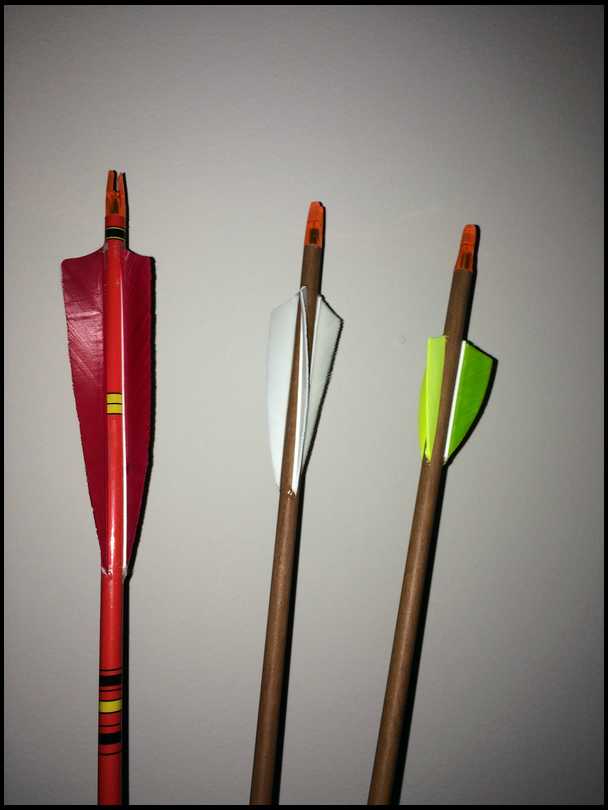
The weather is too bad and muddy to drag all that out George. Waiting for a rain break to go see where 3.5" shields fall in between the other two.
|
|
| From: George D. Stout
|
|
|

|
|
|
|
| Date: 25-Feb-18 |
|
David, it's raining and messy here too. Tom Jennings did a test with a shooting machine and helical versus straight/offset fletch for distance shooting. In the end there was about ten to fifteen yards difference between the two. That kinda disproves that helical slows down too much at hunting distance, or even out to most target distances. Of course any gain is a gain in overall performance as it applies to trajectory.
|
|
| From: David McLendon
|
|
|
|
|
|
|
| Date: 25-Feb-18 |
|
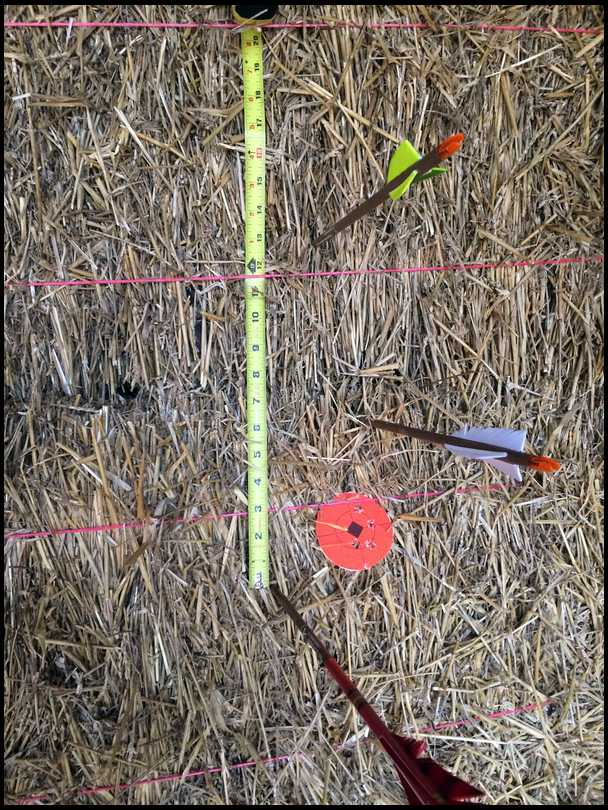
Well here it is, I don't know that I have ever seen 3.5"shield for sale anywhere but that's what I wanted because it split the difference between the first two, so I made them by cutting down some 5". This is not a 3 shot stick'em & click'em, I shot for about 20 minutes and the results were pretty consistent so this fairly represents that. The 3.5" never landed smack in the middle between the two but was about where you see it here. Still I would consider that a significant difference from 5" while the 2" Rayzor is boringly consistent at 12-13" above the 5". I'm still getting used to 3-under and don't need to rush that, but I will shoot each of thses at 5 yard increments out to 45 yards and graph the trajectory and see which one comes closest to my needs for optimizing a fixed gap when the time comes that I'm ready. Then some fletching manipulation may make me able to tailr it to my needs without messing with my arrow weight.
|
|
| From: fdp
|
|
|
|
|
|
|
| Date: 25-Feb-18 |
|
Guys..covering the same distance in less time is the definition of being faster.
|
|
| From: David McLendon
|
|
|
|
|
|
|
| Date: 25-Feb-18 |
|
It is Frank no doubt about it, but they all start out the same, a couple here are just doing a better job of conserving that and stretching it downrange. They hit harder and penetrate a little deeper too.
|
|
| From: George D. Stout
|
|
|

|
|
|
|
| Date: 25-Feb-18 |
|
"Guys..covering the same distance in less time is the definition of being faster."
This should be commmon sense, but we are now in an era of some great ambiguity.
|
|
| From: fdp
|
|
|
|
|
|
|
| Date: 25-Feb-18 |
|
I understand Dave. I'm messin' with ya'.
|
|
| From: David McLendon
|
|
|
|
|
|
|
| Date: 25-Feb-18 |
|
It's a freebie to me, flatter trajectory, more retained energy upon arrival, without upping draw weight or messing with the arrow weight. It's not often these days when you can get more with less.
|
|
| From: fdp
|
|
|
|
|
|
|
| Date: 25-Feb-18 |
|
kginrick...I know that as well. However this isn't a scientific discussion. In any race, over any distance, anywhere in the world, the object, or person, or animal that covered the same distance in less time than another object will be considered faster.
A runner that starts out in the first 400 meters of a race running a pace that if continued would equate to a 4:30 mile, but slows, or decelarates to a pace that ends at a 5:10 mile is said to be slower than the person that starts with the same early pace, and maintains that pace to run a 4:30 mile.
|
|
| From: David McLendon
|
|
|
|
|
|
|
| Date: 25-Feb-18 |
|
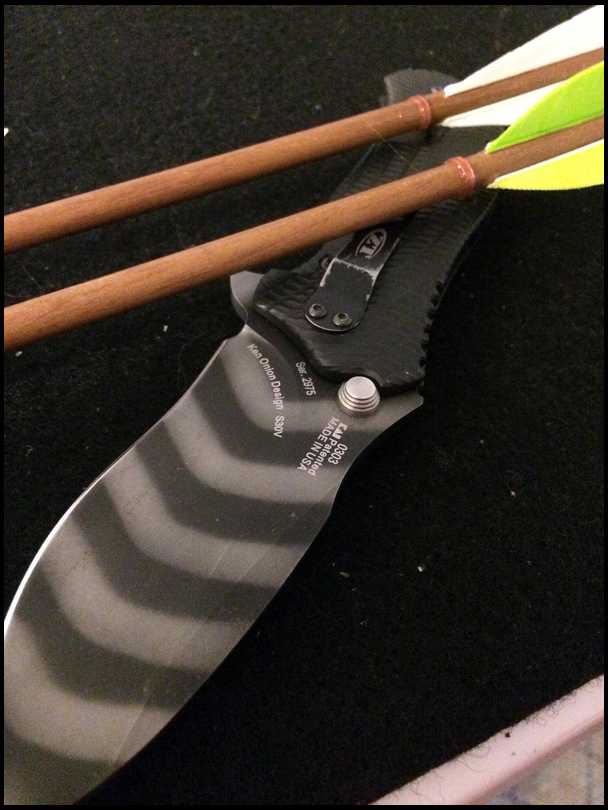
Fletch-tape Turbulators We'll check this out tomorrow...
|
|
| From: M60gunner
|
|
|
|
|
|
|
| Date: 25-Feb-18 |
|
Don’t mean to throw a wrench into this but if your going to compete in a shoot check their regs. The shoot I shot last week said “at least three feathers, four inches long”. Sounded kind of anal to me but it’s their rules. I used four in fletch on my 600 spine arrows. Getting back to the experiment, years ago Bob Learn of Bowhunters Digest fame wrote about just this subject. He used 4 three inch feathers and compared it to 3 five inch feathers in a cross wind with BH’s. His conclusion was the four fletch flew with less side to side movement than the five inch fletch. So, wouldn’t less arrow movement equal a little faster arrow as well?
|
|
| From: David McLendon
|
|
|
|
|
|
|
| Date: 25-Feb-18 |
|
Not as aesthetically appealing to the traditionalist mind, but they definitely perform. The 12-13" separation has been consistent throughout, pretty hard to argue with. I was going to find the point on distance for them but got rained out. It'll wait ntil tomorrow.
|
|
| From: David McLendon
|
|
|
|
|
|
|
| Date: 25-Feb-18 |
|
No Wrench Thomas, I'm tuning for me and my shooting goals. But the fact that at least 4" is required tells you that somebody somewhere has done the homework and realized that less is more.
|
|
| From: Rick Barbee
|
|
|
|
|
|
|
| Date: 25-Feb-18 |
|
David, I've been thinking about using the turbulators again. I just got lazy when I built new arrows, or they would already be on there.
That fletch tape will work just fine. I use automotive pinstripeing tape.
Rick
|
|
| From: David McLendon
|
|
|
|
|
|
|
| Date: 25-Feb-18 |
|
Fletch tape being two layers may cause durability issues down the road but will work tot test. If I like it then I'll likely go to something more durable.
|
|
| From: Birdy
|
|
|
|
|
|
|
| Date: 25-Feb-18 |
|
Very interesting, can't help but think that this is the type of thread that would get you kicked off certain other trad forums. Thanks for the discussion and for showing your results.
|
|
| From: David McLendon
|
|
|
|
|
|
|
| Date: 25-Feb-18 |
|
Why because the feather is not five inches long? If that's the case then I'm not sure I'd want to be there anyway.
|
|
| From: Rick Barbee
|
|
|
|
|
|
|
| Date: 25-Feb-18 |
|
As M60gunner mentioned above. Many competition venues have a 3 X 4" / 12" total minimum for fletching in their rules. The IBO being one of those venues.
I don't make any sense to me, but since I still have the desire to compete again someday, and since I only compete with the same equipment I hunt with, I have gone to the 3 X 4" exclusively. Otherwise I would be using 2, or 2.5 inch
Rick
|
|
| From: David McLendon
|
|
|
|
|
|
|
| Date: 25-Feb-18 |
|
I doubt many folks will switch to 2" feathers and I'm not suggesting that they should. I'm not sure that they will be my go to either, but it is good to know that they alter arrow performance and it is even better to understand why. What anybody does with that knowledge is up to them, but it's better to learn and know than not.
|
|
| From: Rick Barbee
|
|
|
|
|
|
|
| Date: 25-Feb-18 |
|
Speaking of that rule - I have yet to hear any explanation for it.
Rick
|
|
| From: David McLendon
|
|
|
|
|
|
|
| Date: 25-Feb-18 |
|
3"X 4" for 12" total length. I have an assortment of different brand vanes and some are higher than others while being the same length. Reduced surface area can be accomplished by means other than changing length. Trim them down to a lower height and maintain the same profile.
|
|
| From: David McLendon
|
|
|
|
|
|
|
| Date: 25-Feb-18 |
|
Reason for that rule is the people who figured out what has been shown here today would have flatter shooting rigs with smaller gaps less critical of aiming errors over a given distance and walk all over folks shooting rigs with a more significant drop in their trajectory.
|
|
| From: 2 bears
|
|
|
|
|
|
|
| Date: 25-Feb-18 |
|
I have been asking "Are we using too much fletching" for years Yes wind will affect larger feathers more also. You can deny the results and analyze it all you want too. 1 grain = lighter=increase FOC etc. It won't change the results. By the way off set has the effect of helix to a slightly lesser degree as Tom Jennings proved but has nothing to do with feather size. O.K. Bomania where are you. Help.:^) >>>----> Ken
CAUTION CAUTION not for those that say tuning and bare shafting is a waste of time.
|
|
| From: lefty4
|
|
|
|
|
|
|
| Date: 25-Feb-18 |
|
" Very interesting, can't help but think that this is the type of thread that would get you kicked off certain other trad forums. Thanks for the discussion and for showing your results. "
Really? Kicked off the forum for having the discussion? Hummmm
|
|
| From: David McLendon
|
|
|
|
|
|
|
| Date: 25-Feb-18 |
|
Ken that's right, if somebody doesn't believe in or is not very proficient at tuning then this is not something to try. The difference in feather weight is slight and 3 grains total weight is not a factor, surface area and subsequent drag is what is making the difference. 3X2" is 6" of total fletching 1/2" at maximum height 3X3.5" is 10.5" of total fletching 1/2" at mamimum height 3X5" is 15" of total feather length and also contains the longest span of highest profile of 5/8" Those differences are significant as shown by the photos
|
|
| From: 2 bears
|
|
|
|
|
|
|
| Date: 25-Feb-18 |
|
Yes Sir Besides it makes no difference whether it is the weight,the species the feather came from, the color, or the phase of the moon. The results will be the same. The larger the feathers the quicker they slow down, the higher the arc,the more they are affected by wind,and the more noise they make.>>>----> Ken
|
|
| From: David McLendon
|
|
|
|
|
|
|
| Date: 25-Feb-18 |
|
I can't help but agree, and this bit of knowledge along with a few others and a lot of getting used to 3 under is going to help me to set up where I need to be after leaving instinctive and split finger.
|
|
| From: 3arrows
|
|
|
|
|
|
|
| Date: 26-Feb-18 |
|
What about distance?
|
|
| From: David McLendon
|
|
|
|
|
|
|
| Date: 26-Feb-18 |
|
Shooting has all been done from 30 yards which is the point on distance for the 5" fletched arrow. POD for the other two will be longer and determined today, weather permitting.
|
|
| From: Bernie P.
|
|
|
|
|
|
|
| Date: 26-Feb-18 |
|
IMO a better comparison would be which penatrates deeper at shorter ranges.That would show where the difference's between the two comes into play.The larger fletch should stabilize the arrow a little sooner giving deeper penatration out to a given point.
|
|
| From: David McLendon
|
|
|
|
|
|
|
| Date: 26-Feb-18 |
|
Do that and let us know how that goes. If you can properly tune a bare shaft too and compare it to fletching from 10-17.3 yards. If the larger fletching stabilizes and your bare shaft doesn't then your fletching is covering up poor tuning and/or form and release. Start a separate thread on that too so we can keep up.
|
|
| From: Bowmania
|

|
|

|
|
|
|
| Date: 26-Feb-18 |
|
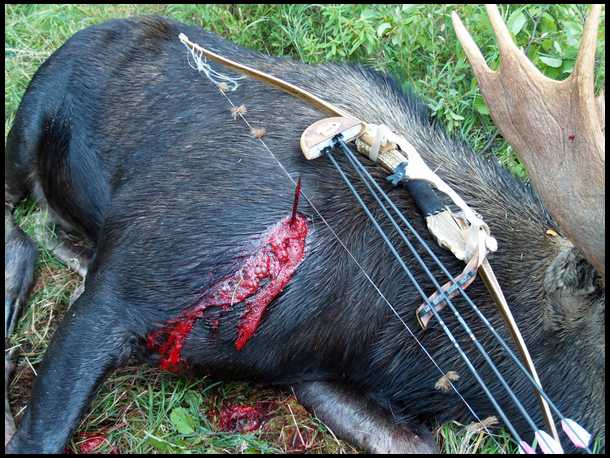
Well, I didn't want to ruin Lefty4's day!!!!!!!!!!!!!!!!
I've been shooting 2 inch regular feathers, not Rayzors, for 6 years. I found an ave of about 4 inches at what turned out to be 22 yards.
The big thing not mentioned here is noise. My tests were with someone behind a 60 inch target at 20 yards, shooting into a target at 30. My ears are shot and I'd say the 5 inch were 50% louder. Probably impossible to measure without a machine.
I found the Rayzors to loud compared to the regular 2 inch feathers. Rayzors were 16MM high compared to the regular fletch which was 13MM.
My test at a chono had a 0 to 1 foot diff. I thought it would have been more. As stated it's the difference in drag.
I did it to milk every bit of energy out of a 50 pound bow for a moose hunt. After 6 years of shooting I think they look like a Porsche compared to a Volkwagon.
Good thread, David.
Bowmania
|
|
|
|
| From: Rick Barbee
|
|
|
|
|
|
|
| Date: 26-Feb-18 |
|
Fletching is a drag. "Pun Intended"
I'd do without it if I could, but I'm not that good.
Since I suck, I use it, but I use only the amount I need, and no more.
The better I tune, the less I need.
The better I shoot, the less I need.
The less I need, the better the delivered energy of the arrow is at the target.
OH & PS
Generally speaking - Less is quieter too. Todd don't know diddly, but he got that part right. Hi Todd. :-)
Rick
|
|
| From: GF
|
|
|
|
|
|
|
| Date: 26-Feb-18 |
|
“My ears are shot and I'd say the 5 inch were 50% louder. Probably impossible to measure without a machine.”
Download a decibel-meter phone app.
I won’t promise you lab-grade calibration from a free app, but it should be much more reliable than a subjective impression. Either that or you could shoot the different fletchings in random order and challenge your listener to identify them by sound, but then you’d never know if it was strictly the volume that they were picking up on....
|
|
| From: David McLendon
|
|
|
|
|
|
|
| Date: 26-Feb-18 |
|
After a brief break in the weather I was able to determine the point on distances for each arrow with all three being identical except for the fletching. Ten shots were made with each arrow 3-under holding point on a 4" orange target dot.
The 5" shield fletched arrow's point on distance is 32 yards.
The 3.5" shield fletched arrow's point on distance is 38 yards.
The 2" Rayzor shield fletched arrow point on distance is 46 yards.
|
|
| From: David McLendon
|
|
|
|
|
|
|
| Date: 26-Feb-18 |
|
BTW that 10 shots per arrow was after I had worked out and nailed down the distance, so each one got two 5 arrow ends to make sure I was on.
|
|
| From: jk
|
|
|
|
|
|
|
| Date: 26-Feb-18 |
|
Spin Wing and similar vanes, tape.
|
|
| From: hawkeye in PA
|
|
|
|
|
|
|
| Date: 26-Feb-18 |
|
Will getting two 4" feathers out of a full lentgh feather off set the cost of a new chopper? ;)
This has been a very interesting thread, thanks.
|
|
| From: Rick Barbee
|
|
|
|
|
|
|
| Date: 26-Feb-18 |
|
I have some pretty sophisticated audio software on my laptop, and some high dollar microphones.
I may use them to get some audio signatures/db levels between a few different fletching types.
Should be easy enough to do. Just set it up, and shoot past it.
I'm betting my 4" vanes will be the quietest by far.
Rick
|
|
| From: David McLendon
|
|
|
|
|
|
|
| Date: 26-Feb-18 |
|
I'd do an experiment and make me a template and cut the height down on the 4" vanes and feathers and see what happens.
Never know what I might do, that's how new things are found. My next work will be point on shooting multiple fletching set ups at 5 yard increments to find which one provides the optimal gap profile for my upcoming fixed gap. That'll be a lot of shooting and feather cutting and graphing. ;^) Sure I could just slap something on and make it work, but that would be boring, I want to find the best and if I find something interesting or unusual along the way, I'll put it on here and we'll all kick it around. After all, hunting season is over for a while...except for PIGS.
|
|
| From: GUTPILE PA
|
|
|
|
|
|
|
| Date: 26-Feb-18 |
|
I use a 3" feather with no problems even a large heads
|
|
| From: David McLendon
|
|
|
|
|
|
|
| Date: 26-Feb-18 |
|
I have used a Tree Shark glue on with 2" on several pigs, now that's a big wide head and they fly great, it all goes back to precise arrow tuning to your bow. If you are slack in that area and or sloppy upon release then minimally fletched arrows will tell on you.
|
|
| From: David McLendon
|
|
|
|
|
|
|
| Date: 26-Feb-18 |
|
I have used a Tree Shark glue on with 2" on several pigs, now that's a big wide head and they fly great, it all goes back to precise arrow tuning to your bow. If you are slack in that area and or sloppy upon release then minimally fletched arrows will tell on you.
|
|
| From: Monte
|
|
|
|
|
|
|
| Date: 26-Feb-18 |
|
Wow. Good thread. Thanks for taking the time to test and share
|
|
| From: 2 bears
|
|
|
|
|
|
|
| Date: 26-Feb-18 |
|
I thought Bowmania would show up. David and Rick I doubt any test of any kind will convince the doubters. They are the same folks that claim tuning and bare shafting is a waste of time. Good luck trying though. >>>----> Ken
|
|
| From: David McLendon
|
|
|
|
|
|
|
| Date: 27-Feb-18 |
|
Todd did show up, and I don't worry about doubters, because this was all laid out straight forward as it happened. And this wasn't a show, I'm working through some things concerning my shooting and this was just part of the process and I thought it might be interesting or beneficial to others. This is actually minor stuff compared to what I'm getting ready to do, but it is good information that may give some food for thought.
|
|
| From: Bowmania
|

|
|

|
|
|
|
| Date: 27-Feb-18 |
|
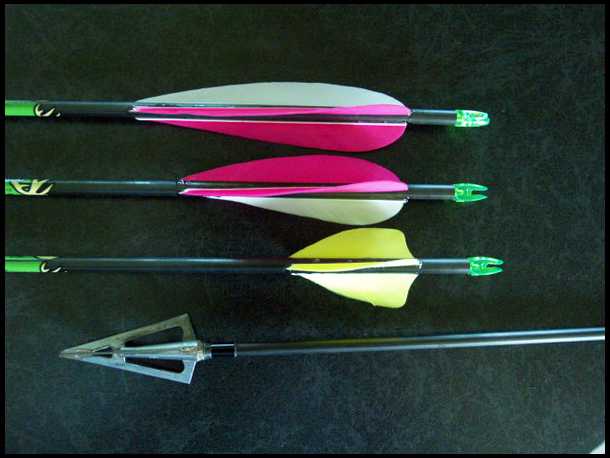
Rick and I have a bet going on this one. Doesn't seem to fair. He wants me to come visit him if I win or loose. That doesn't seem fair. I going to try to get him up in WI in JANUARY. That's about even with me going to TX in JUNE!!!! I hate heat.
Ken, those are the same guys that say, "I've been doing so and so for the last 30 years AND there's a lot of dead animals out there that wish I hadn't." Well, I shot 5 inch feather for over 30 years and killed a lot of animals, but then I found out I was wrong!!! Hey, don't let the kids read that!!
I'd like to do a search for the thread I posted after I was done with my tests. My foggy brain thinks it was real similar to David's, but he was smarter, because I thought I'd find a significant difference at the chrono graph. In addition, once I figured out how good the trajectory was, I never thought I'd get a big broadhead to fly.
Back then I was using the original acsbows.com/bowtuning and back then the broadhead tuning suggested using the biggest, baddest, broadhead you can find. A 160 Snuffer was suggested. (I have one bigger and badder now. I'll do a review in a bit.) I think ACS didn't want to endorse a Snuffer and it has been taken out. I figured if you tune with one, why not shoot 'em. I'm still shooting them today, but running out. I'll buy some if anyone has some for sale. The moose has a 160 STOS in it. Just for penetration, it flew as good as the Snuffer.
Here's a picture from that thread. That Snuffer was beat up then, you should see it now.
Bowmania
|
|
|
|
| From: Bowmania
|

|
|

|
|
|
|
| Date: 27-Feb-18 |
|
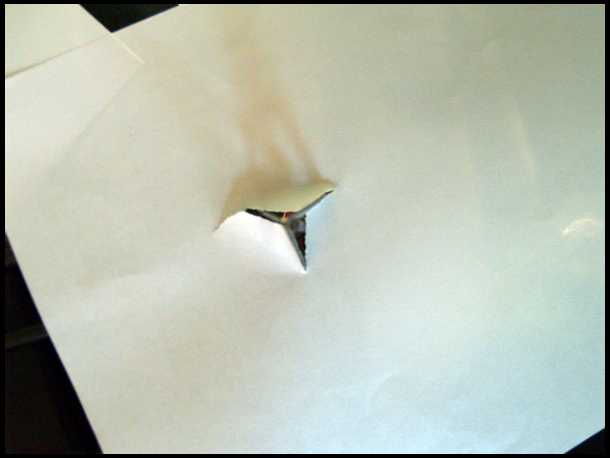
Here's another pic from the tests. It's a Snuffer hole with 2 inch feathers. The paper is for the pics only, it's a little to thick for rips. I shot them through newspaper, but that didn't show in the picture.
Bowmania
|
|
| From: badgerman
|

|
|
|
|
|
|
| Date: 27-Feb-18 |
|
Wow---A great thread with lots of good information. I've been shooting traditional for 61 years and mostly with 5" feathers. After reading this I'm going to be making some changes. I'm getting much better tuning my arrows so I think I'm ready for some shorter fletching. Thanks for the information and keep the new discoveries coming. Joel
|
|
| From: David McLendon
|
|
|
|
|
|
|
| Date: 27-Feb-18 |
|
We could get some really dramatic Chrono results Todd, but it will require putting the chrono at the other end at the target butt and having the Stones to shoot two or three arrows with widely varying trajectories at a small opening 30 yards downrange risking a kill shot on the chrono.
And I just checked and can tell you... I ain't the one. ;^)
|
|
| From: Matthew Wilson
|
|
|

|
|
|
|
| Date: 27-Feb-18 |
|
Excellent thread and appreciate the time and knowledge shared. Will do my best to apply it to my own shooting. Matthew
|
|
| From: Scoop
|

|
|
|
|
|
|
| Date: 27-Feb-18 |
|
Good info and thought. I'm old, old school and have been shooting 5-inch four fletch on woodies for over 50 years, "just because" that's the way we did it back in the day. I might be doing some changing, or at least tinkering. Keep the tests coming and I appreciate your work and comments. It is all enjoyable.
|
|
| From: rraming
|
|
|

|
|
|
|
| Date: 27-Feb-18 |
|
Agree on good thread, at a club I used to shoot at one of the older more experienced guys shot 2" blazer vanes, I just thought it was odd. Not sure the minimum length for broadheads and wind but the compound guys shoot some really small vanes. I have never experimented with shooting broadheads bare shaft since everyone always said you can't but there must be a magical minimum feather needed for shooting them. Don't really care much about what a field point will do.
|
|
| From: Glynn
|
|
|
|
|
|
|
| Date: 27-Feb-18 |
|
I shoot Blazers on most of my arrows, like mentioned here, if your arrows are tuned you can get by with a lot less.
They are a lot quieter than feathers and they are not a disaster in the rain. I know there are good arguments about why not to hunt in rain, but I do hunt out of state on vacation days too.
|
|
| From: David McLendon
|
|
|
|
|
|
|
| Date: 27-Feb-18 |
|
As far as shooting Rayzors with broadheads. I've been using 160 gr Snuffers, 160 gr Magnus 2 blade, 165 gr Simmons Tree Shark 2 blade which are 2" wide. Tuning is the key, refer back to my post on how I bare shaft to very close and then add the Rayzor fletch and continue until perfect.
|
|
| From: Shooter
|
|
|
|
|
|
|
| Date: 27-Feb-18 |
|
rraming----- I don't think anyone is suggesting to bare shaft broadheads. Not a good ideal at all
|
|
| From: Rick Barbee
|
|
|
|
|
|
|
| Date: 27-Feb-18 |
|
Back when I first delved into using short (2") vanes:
just for comparisons sake, I was tuning to shoot with every broadhead in my toolbox, which included the Centaur Big Game, Zephyr Sasquatch, VPA 3 Blade, and a few more I can't recall at the moment.
I was able to make them all shoot perfectly, even with 2" two fletch. It's all in the tuning.
I will admit however, the 2 X 2" was a little tricky with the non vented VPA 3 blade, but I was definitely able to get there.
I put all that work in only to find out I could not use that fletching in IBO competition (which we were trying to heavily push here in Texas at the time), so I just went back to my 3 X 4". Pity
Rick
|
|
| From: David McLendon
|
|
|
|
|
|
|
| Date: 27-Feb-18 |
|
Just for S's & Gee's I'd have to give some fours a haircut and lower the profile and see what happened. Not all 4" feathers and Vanes are created equally. After all, the limit is 4" in length.
|
|
| From: Rick Barbee
|
|
|
|
|
|
|
| Date: 27-Feb-18 |
|
Yeah David, I thought about that, but naa no need. I'm cool with it like it is.
The 4" vanes are probably about the equivalent in drag to a 2 to 3 inch feather anyway. Maybe even less.
Rick
|
|
| From: rraming
|
|
|

|
|
|
|
| Date: 27-Feb-18 |
|
Shooter, didn't mean to imply it but could someone do it please!
|
|
| From: osage
|
|
|
|
|
|
|
| Date: 28-Feb-18 |
|
From a fluid mechanics standpoint, it would seem that the use of a turbulator would slow the translational velocity considerably. Basically causing the laminar flow to become turbulent before reaching the feathers, thus slowing it down. Same principle as dimples on a golf ball, air flow passing around the ball in a laminar fashion, then becoming turbulent well after the ball has passed. Can someone explain how this is used as an advantage ?
|
|
| From: Butch
|
|
|
|
|
|
|
| Date: 28-Feb-18 |
|
Any of you guys ever shoot flu-flu fletched arrows? We shoot them quite often when practicing at flying targets. These arrows have 4 five inch feathers that are approx. 1 3/4 high. When shooting them, they travel fairly well for about 30 yards or so, then drastically lose velocity and fall harmlessly to earth. These arrows really show what different size feathers can do to arrow speed and penetration. The performance differences being discussed here regarding feather sizes is of no surprise.
|
|
| From: Bowmania
|

|
|

|
|
|
|
| Date: 28-Feb-18 |
|
Butch, I think what surprises everyone is that so many people are still shooting 5 inch and have been for 60 years. You'd think the trend might have stated changing after 20, 30 years.
Bowmania
|
|
| From: fdp
|
|
|
|
|
|
|
| Date: 28-Feb-18 |
|
Very good thread. Thanks David.
|
|
| From: David McLendon
|
|
|
|
|
|
|
| Date: 01-Mar-18 |
|
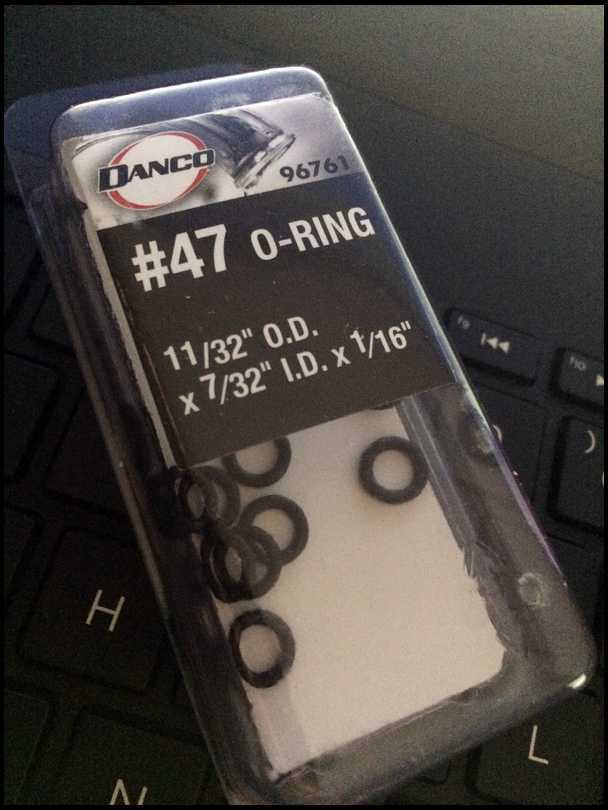
Well it's still raining here so not much shooting has been going on, but I did get out a couple of days ago for a bit and shoot my arrows with the fletch taped Turbulators. After some shooting and a lot of reading about Turbulators on some other forums it looks like there is some merit to them when using shorter fletching and large broadheads. But there is an easier way than taping, you can go to Lowe's or Home Depot and get you some of these O-rings, they will slide right on, fit tight enough and can be easily removed or moved around for testing. The O-ring itself is 1/16" which is the width and height that everything that I have read recommends.
|
|
| From: joe vt
|
|
|
|
|
|
|
| Date: 04-Mar-18 |
|
Great read
|
|
If you have already registered, please sign in now
For new registrations Click Here
|
|
|
|

